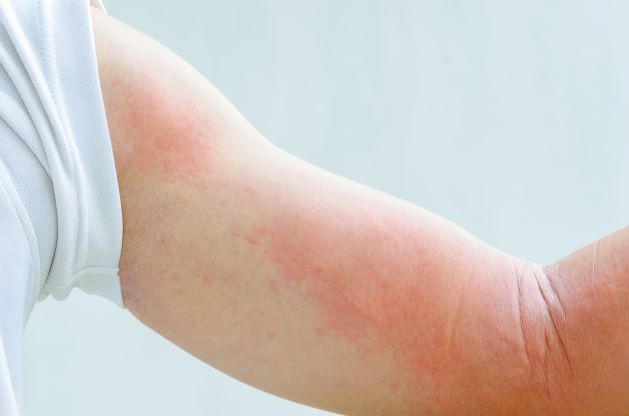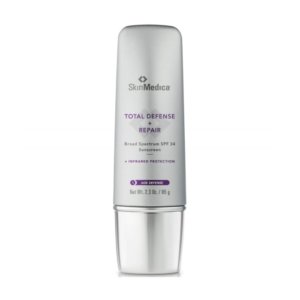If you’re dealing with itchy, red, and irritated skin, you may have hives. According to Dr. Harleen Arora of U.S. Dermatology Partners in Lakewood and Denver, Colorado, “Hives are one of the most common skin conditions. The good news is they are not usually a threat to overall health and wellbeing. The bad news is hives are still painful, itchy, and uncomfortable. There is some additional good news though. Hives can usually be managed with over-the-counter medications or in combination with prescription-strength treatment options.” In this blog, Dr. Arora will discuss what causes hives in children and adults and what treatments are recommended.
What Are Hives?
The medical term for hives is urticaria. This skin condition almost always occurs after exposure to allergens. When hives occur, painful, itchy, red bumps (which are called wheals) will appear on the skin. Hives are characterized as being either acute or chronic. Acute urticaria is what most people think of when they hear hives. In response to some environmental irritant, the skin develops hives. In most cases, these hives clear up within a week. Chronic urticaria is usually a more severe skin condition characterized by flare-ups of hives that can last for several weeks or even months at a time and/or recur frequently. In most cases, chronic urticaria is “idiopathic” meaning no cause can be identified and there is no direct link between an environmental irritant and flare-ups. Typically, chronic idiopathic urticaria requires professional intervention from a dermatologist.
Hives form because the protein histamine is released by the body in response to an allergen, irritant, or other environmental factor. In response to histamine, capillaries leak fluid that accumulates under the skin. This causes the wheals associated with hives to form. While hives are typically small round or ovular bumps, they can also be larger, or smaller hives may develop close together and merge to form a larger lump. In most cases, the rash associated with hives will clear up within a week. However, in some cases, a more serious issue called angioedema develops. This condition leads to large bumps deep within the skin. This can trigger inflammation and swelling in the affected areas. When it occurs on the face or neck, this can be dangerous and cause serious health risks. If you notice severe swelling in combination with your hives, you should consult a medical professional or seek emergency medical intervention as soon as possible. In addition to these basic effects of hives, people may also experience inflammation and swelling in the face, especially in the lips, throat, and around the eyes.
What Causes Hives?
When it comes to the underlying cause of hives, Dr. Arora says, “It’s not always completely clear what caused hives, but in almost all cases, hives develop due to an allergic reaction. This allergic response may be related to something a person eats, medications they’re taking, or certain illnesses. Additionally, the allergy may be to environmental irritants like dander or insect bites. Seasonally, people may experience hives in reaction to things like pollen as well as specific plants like poison ivy, oak, and sumac.” In addition to these common causes of hives, other sources of allergic skin response include:
- Sunlight – In rare cases, people develop skin allergies to sun exposure that can lead to the development of hives.
- Infections – Viral, bacterial, and fungal infections can all cause the formation of hives.
- Systemic illnesses – There are many chronic and systemic health conditions, including lupus and thyroid disease, which may cause hives.
- Pressure or friction – Repeated pressure or rubbing against a specific part of the skin can lead to hives.
- Stress – For certain people, poorly managed stress can lead to the development of hives.
Can Hives Be Prevented?
When it comes to preventing hives, Dr. Arora recommends, “If you frequently break out in hives or have chronic flare-ups, it’s important to talk with a dermatologist to develop an ongoing plan to manage these symptoms. One of the first things your dermatologist will ask you to do is track your potential triggers. This may include a range of things from foods you eat to medications, cleaning products, cosmetics, or even certain clothing items. By pinpointing the underlying cause of your hives, you can begin limiting exposure to these triggers or avoiding them altogether.”
Additionally, people who have frequent hives may want to take the following preventive steps:
- Take an allergy medication daily.
- Address any symptoms of hives at the earliest stages to minimize the severity of flare-ups.
- Wear loose-fitting clothing to avoid skin irritation.
- Apply sunscreen to all exposed areas of the skin before going outdoors. SkinMedica Total Defense+ Repair Broad Spectrum SPF 34 is a good option for sensitive skin with hives.
- Limit time spent in warm or very humid climates.
How Are Hives Treated?
According to Dr. Arora, “Acute urticaria, the most common of the two types of hives, usually clears up on its own in about a week and does not last longer than six weeks. That doesn’t mean you need to be uncomfortable until the hives resolve themselves. There are plenty of steps you can take at home to relieve symptoms of hives. If you have a severe flare-up or symptoms that are resistant to treatment, your dermatologist may also provide prescription medications. This can include oral and/or topical medications formulated to treat itching, irritation, and other symptoms of hives. For more severe hives or chronic idiopathic urticaria, your dermatologist may recommend injected treatments to help quickly suppress the immune response and alleviate symptoms in the short term. In the long term, the dermatologist will likely want to work with an allergist to create an ongoing plan to manage breakouts and keep skin healthy.”
Depending on the individual need, treatment to address hives symptoms may include:
- Antihistamines – oral or topical medications that block histamine production.
- Corticosteroid – oral, topical, or injected medications used to suppress the allergic immune response to histamine production.
- Anti-itch medications – topical products to fight itch and soothe skin.
- Change clothing – wear lightweight, loose-fitting clothing to avoid unnecessary friction or pressure.
- Keep cool – avoid heat and humidity as much as possible.
- Cold compresses – use cold compresses to alleviate itch.
- Moisturize – using a hypoallergenic moisturizer can help soothe skin and avoid adverse health effects like drying and cracking that can occur as hives heal.
- Stress reduction – take steps to relieve stress and avoid stressors whenever possible.
Should I Consult a Dermatologist?
In most cases, hives can be cleared up on their own with at-home care. However, we do recommend reaching out to one of the U.S. Dermatology Partners locations to schedule a visit if you have hives that last longer than a week, the symptoms don’t improve after at-home treatment, they impact your mobility or flexibility, or you have deeper lumps or bumps beneath the hives. Those who struggle with chronic idiopathic urticaria should also develop and maintain a relationship with a dermatologist to manage their chronic skin condition. Finally, we highly recommend children struggling with hives visit a dermatologist as these conditions can be more severe and worsen more quickly in young people. Getting started working with a local U.S. Dermatology Partners location is simple. You’ll just need to take a few moments to complete our online scheduling request form. From there, a member of our dermatology team near your home will be in touch to finalize the details of your visit.
Find a location near me
or



